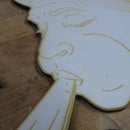Introduction: Making Flexible PCBs With a Laser Jet Printer or Copier
You can make flexible PCBs on the cheap using a laserjet printer or copier- basically anything that uses toner. They have pretty good accuracy, but I wouldn't trust it for anything smaller than an 0805 SMD part, though I have done down to 0804. They're great for making LED boards that you can iron onto fabric! Since the Pyralux is copper coated Kapton (Kapton is a heat-resistive plastic) you can even solder to them once they're ironed on.
You'll need:
-Pyralux, AKA copper-clad kapton. I got mine from DuPont- I wrote them saying I was a researcher and they sent me a bunch. Maybe you'll have the same luck; otherwise eBay works.
-Brillo Pad
-Rubbing alchohol
-Ferric Chloride or other etchant (this is writing assuming you're using Ferric chloride- still conveniently sold at Radio Shack)
-Laser printer or copier
-some sort of graphics program
-nitrile or latex gloves
-SMD parts (these do not work with through hole components)
You'll need:
-Pyralux, AKA copper-clad kapton. I got mine from DuPont- I wrote them saying I was a researcher and they sent me a bunch. Maybe you'll have the same luck; otherwise eBay works.
-Brillo Pad
-Rubbing alchohol
-Ferric Chloride or other etchant (this is writing assuming you're using Ferric chloride- still conveniently sold at Radio Shack)
-Laser printer or copier
-some sort of graphics program
-nitrile or latex gloves
-SMD parts (these do not work with through hole components)
Step 1: First, Prepare Your File in AI (or Any Other Graphics Program)
I made a bunch of different sizes, as I was experimenting. You can do whatever you want.
Step 2: Prepare Your Pyralux
Get some gloves and cut your pyralux into the size of paper you're going to be printing. I used standard letter sized paper. If your pyralux piece is small, tape it to a piece of paper. I suggest taking a piece of plain paper, writing 'up' and an arrow pointing towards the printer (so you know which way to put it in) doing a test print, then taping the pyralux over the correct area. Bam.
To prepare your pyralux, first take some rubbing alcohol and rub down the copper side. You must remove all thumbprints and hand oils. Once you've done that, take your brillo pad, and gently but firmly scuff the entire copper side. The pressure should be enough that you see the copper being marked, but not enough to crinkle it. Don't crinkle it.
Once more, wipe down with the alcohol to remove the copper dust you just created. Wipe with a paper towel. set aside and DO NOT TOUCH AGAIN WITH BARE HANDS. From now until after you develop, don't touch it. Just...don't.
To prepare your pyralux, first take some rubbing alcohol and rub down the copper side. You must remove all thumbprints and hand oils. Once you've done that, take your brillo pad, and gently but firmly scuff the entire copper side. The pressure should be enough that you see the copper being marked, but not enough to crinkle it. Don't crinkle it.
Once more, wipe down with the alcohol to remove the copper dust you just created. Wipe with a paper towel. set aside and DO NOT TOUCH AGAIN WITH BARE HANDS. From now until after you develop, don't touch it. Just...don't.
Step 3: Print!
Place the Pyralux into the printer or copier(with your gloves on!). Make sure it's as smooth as possible, and also check to make sure the Kinko's attendant is busy with Flappy Birds or 2048 or something.
If you're on a copier, set the print to extra dark. Lots of toner= better resistive in the etching stage.
Hit go, or copy, or EXECUTE or whatever.
Do a little dance (with your gloves on!) continue to try to not get kicked out of Kinko's.
When it comes out the other side..take it out (with your gloves on!) and place it in a bag if you're in good 'ol Kinkos, or just asside if you're abusing your own printer.
If you're on a copier, set the print to extra dark. Lots of toner= better resistive in the etching stage.
Hit go, or copy, or EXECUTE or whatever.
Do a little dance (with your gloves on!) continue to try to not get kicked out of Kinko's.
When it comes out the other side..take it out (with your gloves on!) and place it in a bag if you're in good 'ol Kinkos, or just asside if you're abusing your own printer.
Step 4: Etch!
Time to etch your boards. I recomend the wiping method rather than the soaking method. Here's a link. Don't do this at kinkos.
https://www.instructables.com/id/Sponge-Ferric-Chloride-Method-Etch-Circuit-Bo/
be sure to properly dispose of your Ferric Chloride.
https://www.instructables.com/id/Sponge-Ferric-Chloride-Method-Etch-Circuit-Bo/
be sure to properly dispose of your Ferric Chloride.
Step 5: Kabloomers! You Have Boards!
Here are my boards. In this photo I have cut them into strips. That paper behind the boards is double-sided interfacing, which adds an iron-on adhesive to the boards. Yay!
I originally wrote this up for Steampunkworkshop.com. Check it out and other stuff I did/do over there!
I originally wrote this up for Steampunkworkshop.com. Check it out and other stuff I did/do over there!




